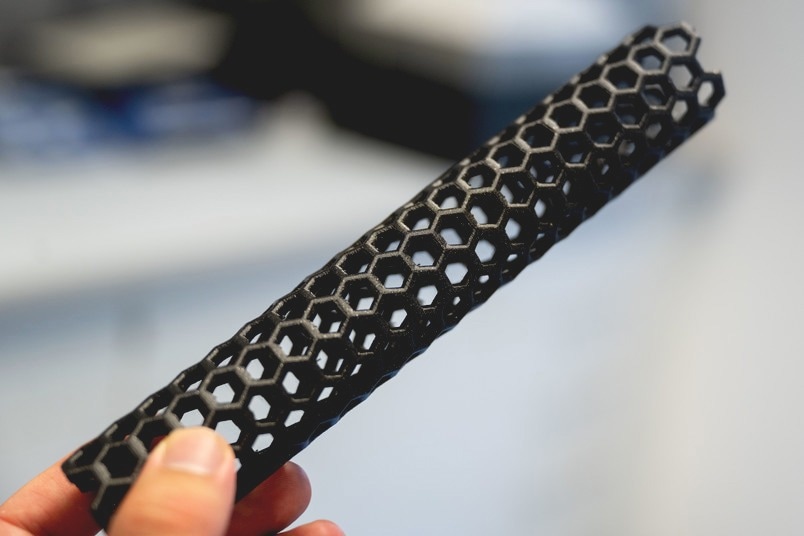An interdisciplinary research group from Bochum, Duisburg, and Zurich has come up with a new method to build modular optical sensors which have the potential to detect bacteria and viruses.

3D printed model of a carbon nanotube, the main building block for the new biosensors. Unlike in this 3D printed model, the real nanotubes are 100,000 times thinner than human hair. Image Credit: © Ruhr Universitat Bochum, Marquard
Scientists utilized fluorescent carbon nanotubes with a new kind of DNA anchor that serves as molecular handles. The anchor structures could be utilized to conjugate biological recognition units like antibodies aptamers to the nanotubes.
The recognition unit interacts with the viral or bacterial molecules in the nanotubes. Such interactions cause an impact on the fluorescence of the nanotubes and increase or decrease their brightness.
A research group including Professor Sebastian Kruss, Justus Metternich, and four co-workers from Ruhr University Bochum (Germany), the Fraunhofer Institute for Microelectronic Circuits and Systems, and the ETH Zurich reported their study outcomes in the Journal of the American Chemical Society, published on June 27th, 2023.
Straightforward Customization of Carbon Nanotube Biosensors
The researchers utilized tubular nanosensors made of carbon and with a diameter of less than 1 nm. When irradiated with visible light, carbon nanotubes liberate light in the near-infrared range. It is not possible to view near-infrared light with the human eye, but it is ideal for optical applications since the level of other signals in this range has been decreased highly.
Sebastian Kruss’ team had already displayed how the fluorescence of nanotubes could be manipulated to detect vital biomolecules in their earlier research. At present, scientists are looking for a way to tailor the carbon sensors for use with various target molecules in a direct way.
The key to success was DNA structures with alleged guanine quantum defects. This involved linking DNA bases to the nanotube to make a defect in the nanotube’s crystal structure.
Consequently, the fluorescence of the nanotubes altered at the quantum level. Besides, the defect served as a molecular handle that enabled to initiation of a detection unit, which could be adapted to the respective target molecule for the cause of determining a particular bacterial or viral protein.
Through the attachment of the detection unit to the DNA anchors, the assembly of such a sensor resembles a system of building blocks–except that the individual parts are 100,000 times smaller than a human hair.
Sebastian Kruss, Professor, Ruhr University Bochum
Sensor Identifies Different Bacterial and Viral Targets
The research group exhibited the new sensor concept utilizing the SARS CoV-2 spike protein as an example. Accordingly, the scientists made use of aptamers that bind to the SARS CoV-2 spike protein.
Aptamers are folded DNA or RNA strands. Due to their structure, they can selectively bind to proteins. In the next step, one could transfer the concept to antibodies or other detection units.
Justus Metternich, Professor, Ruhr University Bochum
With a high degree of reliability, the availability of fluorescent sensors denoted the existence of the SARS-CoV-2 protein. The selectivity of sensors with guanine quantum defects was greater compared to the selectivity of sensors without such defects. Also, the sensors with guanine quantum defects were highly stable in solution.
This is an advantage if you think about measurements beyond simple aqueous solutions. For diagnostic applications, we have to measure in complex environments e.g. with cells, in the blood, or in the organism itself.
Sebastian Kruss, Professor, Ruhr University Bochum
Sebastian Kruss headed the Functional Interfaces and Biosystems Group at Ruhr University Bochum and is also a member of the Ruhr Explores Solvation Cluster of Excellence (RESOLV) and the International Graduate School of Neuroscience.
The study was financially supported by the German Research Foundation as part of the Cluster of Excellence RESOLV (EXC 2033–390677874), the Volkswagen Foundation, and the Fraunhofer Attract Program (038–610097).
Journal Reference
Metternich, J. T., et al. (2023) Near-Infrared Fluorescent Biosensors Based on Covalent DNA Anchors. Journal of the American Chemical Society. doi.org/10.1021/jacs.3c03336.